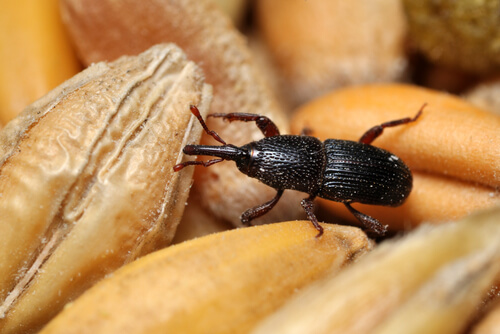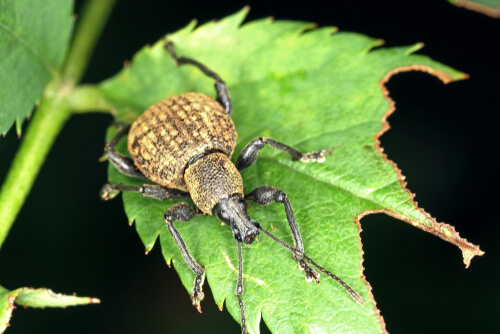5 Species of Weevils: Crop Pests


Written and verified by the biologist Elsa M. de Arribas
Weevils are a group of coleopterans that belong to the Curculionidae family. Some species belonging to this group pose a phytosanitary risk by attacking crops, with their consequent economic impact.
General characteristics of weevils
Weevils are a group of coleopterans – a group that accounts for different pests that affect different types of crops. Their most striking feature is the prominent shape of the chewing apparatus. Their size is smaller than that of other coleopterans. They’re phytophagous and have herbivorous habits.
The body of these beetles is rough and has shades ranging from brown to black depending on the species. A curious characteristic they may practice is thanatosis, which means that in dangerous situations, they can play dead.
Weevil species

1. Anthonomus grandis or boll weevil
Of all the different types of cotton, it’s the American cotton Gossypium hisurtum that’s most affected by the presence of Anthonomus grandis.
This species spreads once the cotton season is over. At that time, the adults take advantage of air currents and spread to areas far from their area of origin.
2. Cylas formicarius or sweet potato weevil
Commonly known as the sweet potato weevil, it can infect other plants of the same family as the sweet potato.
This species has spiders, ants, and earwigs as its main predators. It can also be infected by the fungus Beauveria bassiana, which lives in the soil and frequently kills the weevil.
One measure against this particular weevil is the cultivation of the fungus in coffee or other residues. It’s applied during planting in the soil, thus reducing the weevil population.
3. Rhigopsidius tucumanus or potato weevil
The potato weevil is distributed in three different countries in South America – Bolivia, Chile, and Argentina.
Females lay eggs in forming tubers. When the larvae hatch, they gradually build a gallery under the epidermis. The gallery ends in a chamber, where they enter the pupal stage. Subsequently, the adult remains dormant in the tuber until it’s planted and obtains moisture from the soil.
4. Sitophilus oryzae or rice weevil
Originally from India, it’s one of the most prominent weevil pests. They can be found in rice and maize crops as well as in kitchens, where they prefer dry foods such as cookies or cereals.
5. Khapra beetle
Also known as the grain weevil, this species is considered dangerous for different types of grains or other dry food products that may be stored.
Factors that influence the presence of weevils
Once the weevil is present, it’s very difficult to eradicate it. This is due to the following factors:
- It can survive for a long time without feeding
- Its survival is possible in foods with low humidity
- They can remain hidden in crevices for long periods of time
- They’re tolerant (as far as possible) to different fumigants and insecticides.
For all these reasons, it’s necessary to prevent their appearance, since once it’s inside, it’s very difficult to eliminate it.
How to recognize its presence
Larvae and their exuviae in infected grains are the main indication. However, it’s difficult to differentiate between the different larvae of the genus, so it’s essential to check all cracks, holes, and crevices for their presence. Also, analyses must be carried out to correctly identify the larvae found.
General preventive measures
To prevent the appearance of these species and the consequences of their stay, it’s a good idea to take some tips into account.
If agronomic practices are changed, it can influence the behavior of the plant. This could only be done in specific types of crops, such as cotton. By influencing the crop, these changes can decrease the weevils’ attraction to the crop.
Another practice to consider is crop rotation, as it hinders the pest’s life cycle. It also has other beneficial consequences, such as improving the reproductive capacity of soils and recycling nutrients in them.
In addition, it’s good to get to know the life cycle and behavior of each type of weevil and the crops they target. Above all, the most important thing is to consult an expert and follow their recommendations.
Conclusion

Weevils are responsible for different plagues that affect different types of crops around the world. However, not all weevil species are part of this disaster, and it’s important to comply with the preventive measures suggested by experts.
The economic impact caused by this type of pest is extremely relevant. Therefore, it’s important to get to know the different species that affect each crop and make a correct identification. In this way, the most appropriate treatment can be applied to eradicate these Coleoptera.
Weevils are a group of coleopterans that belong to the Curculionidae family. Some species belonging to this group pose a phytosanitary risk by attacking crops, with their consequent economic impact.
General characteristics of weevils
Weevils are a group of coleopterans – a group that accounts for different pests that affect different types of crops. Their most striking feature is the prominent shape of the chewing apparatus. Their size is smaller than that of other coleopterans. They’re phytophagous and have herbivorous habits.
The body of these beetles is rough and has shades ranging from brown to black depending on the species. A curious characteristic they may practice is thanatosis, which means that in dangerous situations, they can play dead.
Weevil species

1. Anthonomus grandis or boll weevil
Of all the different types of cotton, it’s the American cotton Gossypium hisurtum that’s most affected by the presence of Anthonomus grandis.
This species spreads once the cotton season is over. At that time, the adults take advantage of air currents and spread to areas far from their area of origin.
2. Cylas formicarius or sweet potato weevil
Commonly known as the sweet potato weevil, it can infect other plants of the same family as the sweet potato.
This species has spiders, ants, and earwigs as its main predators. It can also be infected by the fungus Beauveria bassiana, which lives in the soil and frequently kills the weevil.
One measure against this particular weevil is the cultivation of the fungus in coffee or other residues. It’s applied during planting in the soil, thus reducing the weevil population.
3. Rhigopsidius tucumanus or potato weevil
The potato weevil is distributed in three different countries in South America – Bolivia, Chile, and Argentina.
Females lay eggs in forming tubers. When the larvae hatch, they gradually build a gallery under the epidermis. The gallery ends in a chamber, where they enter the pupal stage. Subsequently, the adult remains dormant in the tuber until it’s planted and obtains moisture from the soil.
4. Sitophilus oryzae or rice weevil
Originally from India, it’s one of the most prominent weevil pests. They can be found in rice and maize crops as well as in kitchens, where they prefer dry foods such as cookies or cereals.
5. Khapra beetle
Also known as the grain weevil, this species is considered dangerous for different types of grains or other dry food products that may be stored.
Factors that influence the presence of weevils
Once the weevil is present, it’s very difficult to eradicate it. This is due to the following factors:
- It can survive for a long time without feeding
- Its survival is possible in foods with low humidity
- They can remain hidden in crevices for long periods of time
- They’re tolerant (as far as possible) to different fumigants and insecticides.
For all these reasons, it’s necessary to prevent their appearance, since once it’s inside, it’s very difficult to eliminate it.
How to recognize its presence
Larvae and their exuviae in infected grains are the main indication. However, it’s difficult to differentiate between the different larvae of the genus, so it’s essential to check all cracks, holes, and crevices for their presence. Also, analyses must be carried out to correctly identify the larvae found.
General preventive measures
To prevent the appearance of these species and the consequences of their stay, it’s a good idea to take some tips into account.
If agronomic practices are changed, it can influence the behavior of the plant. This could only be done in specific types of crops, such as cotton. By influencing the crop, these changes can decrease the weevils’ attraction to the crop.
Another practice to consider is crop rotation, as it hinders the pest’s life cycle. It also has other beneficial consequences, such as improving the reproductive capacity of soils and recycling nutrients in them.
In addition, it’s good to get to know the life cycle and behavior of each type of weevil and the crops they target. Above all, the most important thing is to consult an expert and follow their recommendations.
Conclusion

Weevils are responsible for different plagues that affect different types of crops around the world. However, not all weevil species are part of this disaster, and it’s important to comply with the preventive measures suggested by experts.
The economic impact caused by this type of pest is extremely relevant. Therefore, it’s important to get to know the different species that affect each crop and make a correct identification. In this way, the most appropriate treatment can be applied to eradicate these Coleoptera.
All cited sources were thoroughly reviewed by our team to ensure their quality, reliability, currency, and validity. The bibliography of this article was considered reliable and of academic or scientific accuracy.
-
Hernando Suárez Gómez, Luis A. Castro Ortega. El Picudo Del Algodonero — Una Superplaga. – Google Libros [Internet]. Colombia: Corpoica; 1996 [citado 28 de junio de 2019]. Disponible en: https://books.google.es/books?id=hahiWYlXqMEC&pg=PA5&dq=Anthonomus+grandis&hl=es&sa=X&ved=0ahUKEwjPiOrJv4rjAhUM_BQKHR8-CyYQ6AEITDAG#v=onepage&q=Anthonomus%20grandis&f=false
-
Gorgojo del Tubérculo de la Papa | Crop Science [Internet]. [citado 28 de junio de 2019]. Disponible en: https://cropscience.bayer.com.ar/content/gorgojo-del-tub%C3%A9rculo-de-la-papa
-
Alex Enrique Bustillo, Bustillo Pardey. (PDF) El gorgojo khapra, Trogoderma granarium Everts (Coleoptera: Dermestidae) plaga cuarentenaria para Colombia. Research Gate [Internet]. julio de 2009 [citado 12 de julio de 2019]; Disponible en: https://www.researchgate.net/publication/271642826_El_gorgojo_khapra_Trogoderma_granarium_Everts_Coleoptera_Dermestidae_plaga_cuarentenaria_para_Colombia
-
E. van de Fliert, Ann R. Braun. Escuela de campo de agricultores para el manejo integrado del cultivo de Camote. [Internet]. Vol. Centro Internacional de la Papa. 2001 [citado 12 de julio de 2019]. Disponible en: https://books.google.es/books?id=CPnN3x7a-HkC&pg=RA2-SA111-PA54&dq=clases+de+gorgojos+en+plagas&hl=es&sa=X&ved=0ahUKEwiyyIWp8q7jAhWYBWMBHX0DAdkQ6AEILDAB#v=onepage&q=gorgojo&f=false
This text is provided for informational purposes only and does not replace consultation with a professional. If in doubt, consult your specialist.








